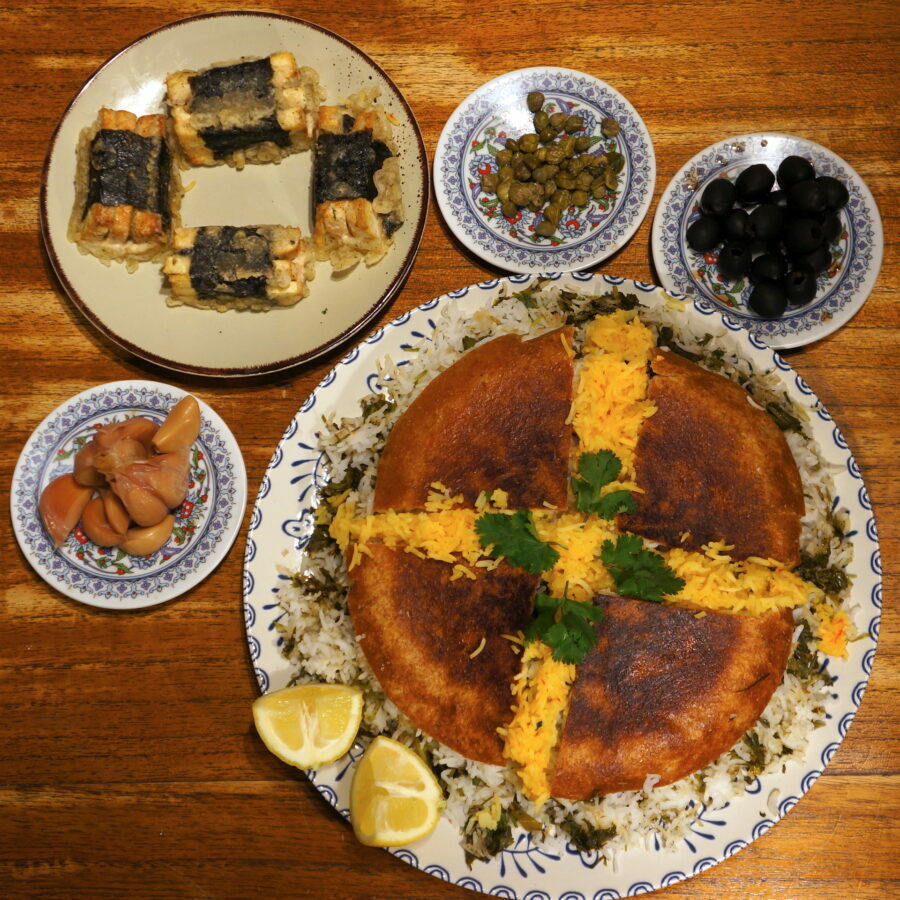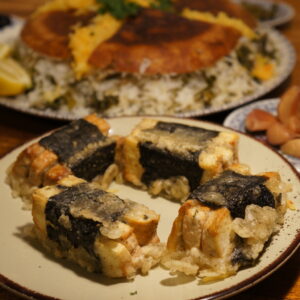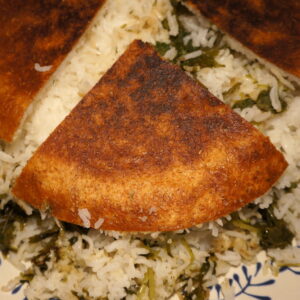
Fresh herbs give this Iranian rice dish a Spring feeling. Enjoy this Sabzi Polo with crispy tahdig, vegan tofu fish and lemon for your Nowruz celebration and throughout the year.
Sabzi Polo and Nowruz
Sabzi Polo is an Iranian herb rice pilaf usually served with fish. This vegan recipe includes instructions on how to make the best tofu fish with nori seaweed and capers. You can also use this battered fish recipe for other meals such as fish and chips.
‘Sabzi’ translates to herbs or vegetables and ‘polo’ means rice. Sabzi polo is a typical dish for Nowruz (Iranian New Year, 21 March). Nowruz marks the Spring equinox and is celebrated in several countries with various traditions. One of the traditions that has recently become popular is to decorate a table with Haft-sin (translating to seven things beginning with a letter that sounds like ‘seen’). These items are:
Sabzeh (سبزه) – bean or grain sprouts – symbol of rebirth and growth
Samanu (سمنو) – wheat germ sweet pudding – symbol of power and strength
Senjed (سنجد) – olives – symbol of love
Serkeh (سرکه) – vinegar – symbol of patience
Seeb (سیب) – apple – symbol of beauty
Seer (سیر) – garlic – symbol of health and medicine
Somāq (سماق) – sumac – symbol of sunrise
I think Sabzi Polo is a beautiful choice for the first day of Spring because it tastes fresh and tangy. For this recipe, you can also forage herbs such as wild garlic to really feel the miracle of new growth. I have been meaning to release a recipe for Nowruz for a few years now and I have finally started with this post! I hope to release recipes for vegan foods that can be cooked for Nowruz each year. So watch this space…
Cooking tips
This recipe layers up rice with herbs, but you can mix them together then put them all on top of the tortilla tahdig if you prefer. This would ensure you get herbs in every bite.
If this is your first time cooking Iranian tahdig rice then here are some tips for getting the perfect tahdig:
- don’t skip steps – you need to rinse and soak the rice
- start with very hot oil to prevent sticking before cooking on low heat
- don’t worry if your tahdig is a little charred or not quite cooked – perfect tahdig is traditionally a symbol of a skilled cook in Iranian cuisine
Ingredient swaps
Many recipes on the internet encourage you to use fresh herbs but it can be difficult to find them in your local shop if out of season. So you can use dried or frozen herbs as an alternative. Try any combination of the following herbs:
- dill
- coriander
- parsley
- chives
- the green ends of spring onions
- wild garlic

For the tofu fish, I used extra firm smokey tofu. This texture was slightly firmer than a real fish so you might want to try just firm tofu and use cocktail sticks to hold it together while cooking.

Underneath the rice, you can make tahdig without bread if you like crispy rice. Or you can use sliced potatoes – these would need cooking on high heat for a couple of extra minutes.

Iranian rice
If you like this recipe you might also like to try the following rice recipes. They all include delicious tahdig but can be cooked with different fillings and sauces / khoresht.
Polo – mixed rice – برنج مخلوط
Ingredients
- For the tofu fish
- For the herb rice
- Optional garnishes
Instructions
- Prepare the rice 2 hours before cooking. Rinse the rice until the water runs clear. I usually fill and empty a bowl 5 times. (You can use this water to water house plants.) Then leave the rice to soak in water and add the salt. If you will be making tofu fish, you can also make the batter now. Combine the flour, cornstarch, baking powder, pepper, salt and fenugreek in a bowl. Slowly add water until you have a smooth batter. You can use a bit of lemon juice and the sauce from the capers if you want to add a tang.
- Boil the rice in the salted water and add more water if needed. Cook the rice until only just soft because you will be steaming it next. (It can be a little chewy but not hard.) While the rice cooks, finely chop the herbs and mix them together in a bowl. Prepare the liquid saffron by grinding the saffron into a powder (you can add a little sugar to help) and mix with 3 tbsp hot water. Leave to use later.
- If you are making tofu fish, you can also prepare this while the rice cooks. Slice the tofu into pieces about 0.5cm thick by 3cm wide. Press with a paper towel to remove excess water. Chop or blend a sheet of nori then add the capers and blend. Spread this mixture across the tofu pieces then split into 8 groups and stack each group of tofu. Tightly wrap each stack in a quarter of a nori sheet so that the tofu sticks out at both ends. Use a little water to stick the overlapping nori together. If the stacks of tofu feel unstable, you can hold them together with cocktail sticks during the cooking process but remember to remove them before serving.
- When the rice is ready, drain and splash with cold water. Cover the base of a pan with oil and heat up. If necessary, cut the tortilla wrap to fit inside the pan. Carefully lie the tortilla wrap on the base of the pan and turn the heat to low. Beginning and ending with rice, layer up the rice and herbs sprinkling each layer into the pan. Create a mountain shape by pulling the rice away from the sides of the pan, preventing them from sticking. Poke three holes into the mountain of rice with the handle of a wooden spoon. This helps steam to circulate in the pan. Place a lid wrapped in a tea towel onto the pan, keeping the steam inside. Cook on low heat for around 20-30 mins. But of course, if you smell burning turn it off - tahdig is difficult to get right as it depends on the thickness and size of the pan, and the strength of fire. Try not to remove the lid to test the rice, as the steam will escape. The rice should be light and fluffy when ready.
- While the rice steams, cook the tofu fish. Cover the base of a frying pan with oil and heat up. The oil is hot enough when a drop of batter bubbles, cooks and floats. One by one, dip each stack of tofu in the batter and carefully place in the pan. You can adjust the heat so the oil continues to bubble around the batter but doesn't get too hot and burn. Cook the tofu stacks on the four long sides for a couple of mins each. The batter should lightly brown. If there is uncooked batter on the two ends, you can cook these too by holding the tofu up with utensils. As each one is cooked, place on a plate with a paper towel to soak up excess oil.
- Time to serve! Take a couple of tablespoons of rice and place in the liquid saffron. This will give the rice a yellow colour and a fragrant taste. Leave aside. If you have a large enough plate, carefully (and with a good grip on pan and plate) place the plate on top of the pan of rice and flip upside down. Lift the pan and hopefully, you have a pile of rice with a beautiful complete tahdig on top. If not, don't worry, you can take pieces of tahdig off the bottom of the pan, place on top of the rice and it will still taste great! I decorated my sabzi polo by cutting the tahdig into quarters then sprinkling the yellow saffron rice in between in a cross shape. Serve the tofu fish on the side along with garnishes such as lemon wedges, capers, olives and pickled garlic. Enjoy!
Notes
Did you make this recipe? Tag @vegan_middle_east on Instagram or comment below.